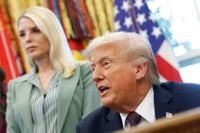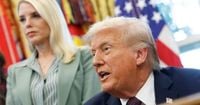On a brisk Tuesday morning, September 16, 2025, the air outside the White House was charged with tension as President Donald Trump prepared to depart for London. Reporters gathered on the South Lawn, eager to press the president on a series of explosive developments that had thrust the administration’s stance on free speech and media criticism into the national spotlight. The catalyst: the recent assassination of conservative activist Charlie Kirk, which had ignited fierce debate over the boundaries of hate speech and the First Amendment.
The day’s most dramatic moment unfolded when Jonathan Karl, ABC News’ Chief Washington Correspondent, questioned Trump about Attorney General Pam Bondi’s vow to crack down on hate speech. Bondi had declared just a day earlier on Katie Miller’s podcast, “There’s free speech and then there’s hate speech, and there is no place — especially now, especially after what happened to Charlie — in our society. We will absolutely target you, go after you, if you are targeting anyone with hate speech, anything, and that is across the aisle.” Her comments, referencing Kirk’s assassination, sent shockwaves across the political spectrum.
Karl, referencing this hardline stance, asked, “A lot of your allies say that hate speech is free speech. What do you make of Pam Bondi saying she’s gonna go after hate speech?” Trump, visibly bristling, shot back, “She’ll probably go after people like you, because you treat me so unfairly. You have a lot of hate in your heart. Maybe they will come after ABC. ABC paid me $16 million recently for a form of hate speech. Your company paid me $16 million for a form of hate speech, so maybe they will have to go after you.”
This wasn’t just rhetorical bluster. Trump’s reference to the $16 million settlement pointed to a recent legal victory: ABC News had paid the sum to settle a lawsuit after anchor George Stephanopoulos incorrectly stated on air that Trump had been found civilly liable for rape in the E. Jean Carroll case, when the actual verdict was for sexual abuse and defamation. The distinction, though subtle, carried significant legal and reputational weight. According to The New York Daily News, Trump boasted, “Your company paid me $16 million for a form of hate speech, so maybe they’ll have to go after you,” underscoring his willingness to use legal tools against perceived slights from the press.
But the president’s ire wasn’t reserved for domestic journalists alone. Earlier that day, an Australian Broadcasting Corporation reporter, John Lyons, had questioned whether it was appropriate for a sitting president to maintain extensive business dealings while in office. Trump responded sharply, “Well, I’m really not. My kids are running the business. I’m here.” Then, in a pointed threat, he added, “In my opinion, you are hurting Australia very much right now, and they want to get along with me. You know your leader is coming over to see me very soon. I’m going to tell them about you. You set a very bad tone.” As the exchange grew testy, Trump could be heard telling the reporter to “set a nicer tone” and barked “quiet!” when a follow-up question was attempted, as reported by Newsweek.
Back to the domestic front, Trump’s confrontation with Karl was emblematic of a broader strategy. Just hours after the exchange, he announced a $15 billion lawsuit against The New York Times, accusing the newspaper of a “decades long method of lying about your Favorite President (ME!), my family, business, the America First Movement, MAGA and our Nation as a whole.” The Times, for its part, dismissed the suit as meritless and “an attempt to stifle and discourage independent reporting.”
Attorney General Pam Bondi’s initial remarks on hate speech had already stoked controversy. On social media, she attempted to clarify: “Hate speech that crosses the line into threats of violence is NOT protected by the First Amendment. It’s a crime. For far too long, we’ve watched the radical left normalize threats, call for assassinations, and cheer on political violence. That era is over.” Her comments, however, drew criticism from both sides. Charles C.W. Cooke wrote in National Review, “She won’t ‘target’ or ‘go after’ anyone for ‘hate speech,’ because, legally, there is no such thing as ‘hate speech’ in the United States, and because, as a government employee, she is bound by the First Amendment. And if she tries it anyway? The Supreme Court will side against her, 9-0.”
On ABC’s The View, Alyssa Farah Griffin noted, “Donald Trump energized a lot of young people by running as a sort of free speech absolutist and warrior. … In these recent days, these leaning into cracking down on it and targeting people when they exercise it is very concerning to me. Charlie Kirk, who they are honoring, is someone who rabidly opposed cracking down on free speech.”
The administration’s new posture on hate speech has been described as a sharp reversal from prior conservative positions. Outlets like The Bulwark and Rolling Stone observed that Trump and his allies, including Bondi, had long championed free speech—even for the most controversial viewpoints. But now, following Kirk’s murder, the White House appeared poised to target what it described as left-wing incitement, with Vice President JD Vance and policy adviser Stephen Miller both vowing to punish groups they accuse of encouraging attacks on conservatives.
The legal and constitutional implications of this strategy are profound. Civil liberties advocates warn that any crackdown on political dissent risks trampling on First Amendment protections. Indeed, as The Associated Press noted, none of Trump’s high-profile media lawsuits have made it to court, but the settlements with ABC and CBS are being touted by the president as victories in his campaign to “restore integrity to journalism.”
Meanwhile, the case of Charlie Kirk’s assassination remains a flashpoint. Prosecutors in Utah allege that the accused killer, Tyler Robinson, was motivated by opposition to Kirk’s message, believing he was spreading “too much hate.” The administration’s response—vowing to silence or punish groups it blames for such violence—has only intensified the debate about the limits of political speech and the risks of government overreach.
Democrats and free speech advocates point out the inconsistency in the administration’s rhetoric, noting that Trump and his allies have, in the past, mocked or minimized attacks on liberal figures. The new push, critics argue, is less about public safety and more about retribution against perceived enemies.
As the president boarded Marine One, the questions lingered: Where is the line between hate speech and free speech? Who gets to decide? And in a nation founded on robust, even unruly debate, what happens when the government itself becomes the arbiter of acceptable speech? For now, the answers remain as contested as ever, with the stakes—legal, political, and cultural—higher than they’ve been in years.



